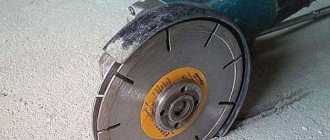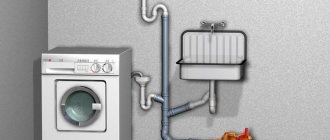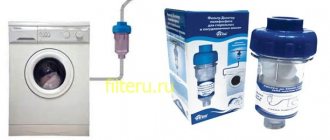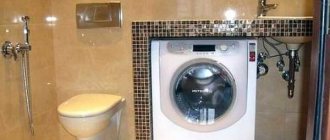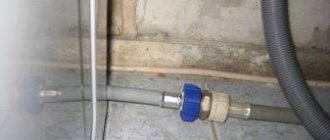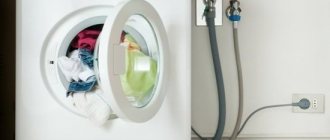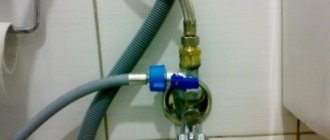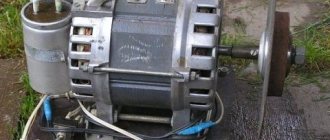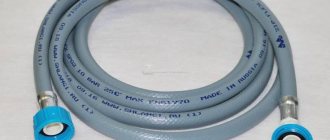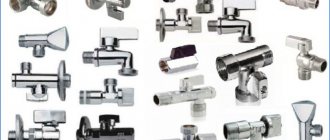SlavagodM
33235 0 3
SlavagodM July 14, 2016Specialization: master of interior and exterior finishing (plaster, putty, tiles, drywall, lining, laminate, etc.). In addition, plumbing, heating, electrical, conventional cladding and balcony extensions. That is, the renovation of an apartment or house was done on a turnkey basis with all the necessary types of work.
Connecting a washing machine to the sewer with a pipe with a diameter of 32 mm
If you need to know how to connect a washing machine to the sewer, then you have come to the right place for advice. I want to talk about two main methods that can generally be applied in this case. In addition, I will explain the features of the sidebar, and also invite you to watch the video in this article.
Two methods
The sewer hose for the washing machine can be fixed to the bathroom
There is another, third way, which you see in the photo above. But this is no longer a connection, but simply fixing the hose with a U-shaped adapter over the side of the bathroom. This U-shaped fitting is included in the kit for every automatic washing machine.
Method one
The blue arrow indicates the location of the connection of the drain hose from the washing machine.
It is not for nothing that I focus your attention on the automatic machine, since there the water is drained forcibly. Therefore, all the instructions below apply specifically to this type of washing machine:
- on the plumbing market there are currently on sale siphons for sinks, sinks and bathtubs with an additional outlet for connecting a hose 22 mm in diameter;
- we can say that there are much more such siphons (with an additional outlet) offered than conventional ones;
- If you install such a siphon, but for some reason you will not connect the washing machine, then the output can be closed with the plug included in the kit.
Method two
Connection via reduction to a 50 mm tee
But the correct connection of the washing machine to the sewer directly into the pipeline may differ slightly:
- the hose, which is intended for draining water in an automatic washing machine, has a diameter of 22 mm , but there is no special socket at the outlets for 50 mm or 32 mm pipelines;
- therefore, for connection, a rubber reduction is used here with a transition to 22 mm - its price is rather symbolic, but the device is quite suitable for its purpose - it is convenient and airtight;
- if your washing unit is located in close proximity to a 50mm sewer pipe, then of course you will be cutting into it through a tee;
- but if the machine is located at the other end of the room, then you should use a 32 mm PVC pipe, connecting it to a 50 mm outlet;
- in such cases, the scheme for connecting the washing machine to the sewer does not require installation of the 32nd pipe at a slope , since the drainage here is forced;
- The 32nd pipe is also connected to the outlet socket of the 50th pipe using a rubber reduction.
Installation of rubber reduction
The drain hose on some units has a diameter of 19 mm on the machine side and 22 mm on the pipeline side.
Are adapters needed for sewer pipes?
Setting up the drain of a washing machine or sink does not require the installation of additional adapters. Moreover, all internal sewer wiring is carried out with components of the same diameter - for convenient operation and repair. Additional elements, fittings, angles, tees and crosses, also repeat the same size. Manufacturers of automatic machines take into account existing housing standards and produce equipment that meets them.
Modern washing machines are connected to the sewer without adapters.
The only exception would be the toilet. For obvious reasons, it is connected to larger diameter pipes to minimize the likelihood of blockages. Thus, the outlet is mounted in a 110 mm tee, commensurate with the sewer riser. Afterwards, an adapter with dimensions of 100x50 is fixed, and then standard wiring follows.
To connect a washing machine to the sewer, you only need an adapter rubber cuff of the following sizes:
- internal diameter – commensurate with the inlet part of the machine’s drain hose;
- external - equal to the circumference of the bell.
If drainage is established through the washbasin siphon, then an adapter rubber band is not required. The corrugation is securely fixed in the socket angle or tee, where the sealing ring is already located. The last element ensures the necessary tightness.
Internal sewerage distribution is carried out with pipes of the same diameter, which simplifies the connection and operation of household appliances.
Features of connecting a washing machine
Correct bend of the drain hose
First of all, you should know if your washing machine has a check valve on the drain that only allows water to flow in one direction. Only in this case will you be able to figure out how to properly connect the washing machine to the sewer.
If such a device does not exist, then the manufacturer must indicate the height level at which the hose loop should be located - a water seal is created in this area. This seal mainly serves to prevent the leakage of unpleasant odors that may come from the drain pipe through the machine.
Drain hose for washing machine
In the latest models of automatic washing machines, for the most part, a non-return valve is provided, so in this regard there should be no questions about how to connect the hose. Your task is only to correctly connect the end pipe (it is smooth, without corrugation) with a rubber reduction or with an additional siphon outlet.
In order not to damage the rubber reduction, I usually lubricate it with liquid dishwashing detergent - this makes it easier to pack it into the socket and insert a smooth pipe into it.
The hose pipe is tightened with a coupling number 8
If the connection is made through an additional siphon outlet, then you just need to remove the tube that is inserted there from the factory and install a hose pipe instead. To seal the connection, there is a coupling - it is indicated by the number 8 in the image - it presses against the conical gasket, which, in fact, provides a seal in this place.
That is, the tube that is in this siphon from the factory is installed there more to keep these parts in working condition.
You can use fittings for extension
If a standard drain hose does not reach the place where it inserts into the sewer, then it can be increased by adding a piece of the required length and connecting these fragments with a fitting and safety with 16x27 mm steel clamps. As I already said, the end pipes can have different diameters, which is why there are connecting fittings for two options - you see them in the top photo.
Modular hose
There are also modular hoses on sale, where each fragment is 0.5 m long, so you can implement any requests. But do not forget that the longer the outlet, the more difficult it is for the pump to cope with the water supply.
Parameters of different types of pipes
The parameters of sewerage structures for private houses do not exceed 110 mm, for apartment buildings – 160 mm or more. When installing a sewer system, it is recommended to use structures with the same parameters.
The calculation results largely depend on the volume of wastewater. For this reason, it is important to carry out calculations taking into account the amount of plumbing equipment. It is also worth paying attention to the throughput of the sewer pipe.
Before carrying out calculations, the installation points of plumbing equipment are also marked, taking into account turns and connection points. When installing a system in an apartment building, many indicators are calculated (resistance coefficient, wastewater transportation speed, and much more). However, for household installation in an apartment or private house, you don’t have to make such complex calculations.
Pipes made from different types of materials have different diameters:
- Plastic structures. For the internal system, products with parameters of 32 mm, 50 mm and 110 mm are usually used. Designs with parameters from 110 mm are suitable for external systems;
- PVC structures. Standard parameters: 32 mm, 50 mm and 110 mm. For external sewerage systems, designs with parameters of 110-500 mm are used. The thickness of their walls can reach 15 mm;
- Cast iron structures. They are very rarely used for installation of internal structures. The most common parameters: 50-300 mm. There are also products in larger sizes. The parameters can be found by looking at the product labeling.
In order to select a product with the desired diameter, you need to look at the minimum drain parameters for specific plumbing fixtures. All information is given in the technical documentation of the equipment.
Connection to water supply
Water supply hose
In this case, oddly enough, connecting the unit to the water supply is much easier than to the sewer, since here, in fact, there is no choice. In any case, the water supply pipeline must be located near the automatic machine and there must be shut-off valves in the form of a straight or corner valve. There are two clamping nuts on the hose itself, therefore, there must be a fitting with an external thread on the machine itself and on the shut-off valve.
Connection to water supply shut-off valves
It is noteworthy that the nuts are designed for a 3/4-inch diameter, therefore, the shut-off valves must have the exact same thread. But if a special tap that is designed for this purpose is made at 3/4, then the water supply wiring most often has 1/2 inch. Therefore, in some cases a reducing fitting will be required for connection.
Preparation is the key to success
Connecting the drain is important, and we will talk about it in great detail, but first I will briefly tell you how to install a washing machine.
Of course, each new unit has detailed instructions; I will not retell them, but will only outline the most important, fundamental points:
Connection to the water supply through a ball valve.
- If you brought the machine into the house from the cold, give it a couple of hours to warm up to room temperature. Modern electronics are quite capricious and can malfunction;
- Any new unit of this size is equipped with various types of seals and stands. They are needed to avoid damage to the equipment during transportation. In the washing machine, in addition to the cardboard box itself and the foam seal, there are often several supporting wooden blocks at the bottom, a kind of mini-pallet. So it needs to be completely removed;
- It doesn’t matter whether you bought a front-facing or vertical machine, the working tank in these units is, figuratively speaking, in limbo. And to prevent these hangers from breaking during transportation, the tank is secured with several rebolts. They must be unscrewed, otherwise the device will break at the first start and the warranty will be invalid, since this point is specified in the instructions. By the way, the instructions must contain a diagram with the locations of these bolts. The holes from the bolts are plugged with plugs included in the kit;
The location of the bolts for fixing the working tank on one of the models.
- The socket must be, as they say now, of the European type, that is, with grounding;
- At the last stage of preliminary preparation, the legs are screwed in and the device is aligned clearly on the horizon. It is advisable to set using a level.
Horizontal alignment.
Do not rush to throw away everything that you removed from the device during preparation. This is especially true for bolts for fixing the working tank. After all, perhaps the time will come and you will need to transport it somewhere again.
Since we have to do plumbing work, we need to prepare the necessary minimum tools.
As a rule, any good owner always has this minimum somewhere in the pantry.
Minimum set, side cutters and pliers with screwdrivers.
- You will definitely need pliers and a pair of high-quality screwdrivers, Phillips and straight;
- The above-mentioned repair bolts may have different head configurations in different washing machine models. Therefore, if you do not have a complete set of keys, it is better to inquire about this point in the store and immediately buy at least 1 of these keys;
Removing the transport bolt using a 10 mm wrench.
- If you are planning a major drain installation, you may have to cut the sewer pipes to size. Professionals use a pipe cutter for this, but personally, when I encountered such a problem, I cut the pipes with a hacksaw;
- Of course, all parts are supplied with gaskets and seals, but I always recommend additionally lubricating these seals with silicone sealant. There is no need to spend money on a large construction tube with a gun; a small tube is enough.
Universal sealant.
